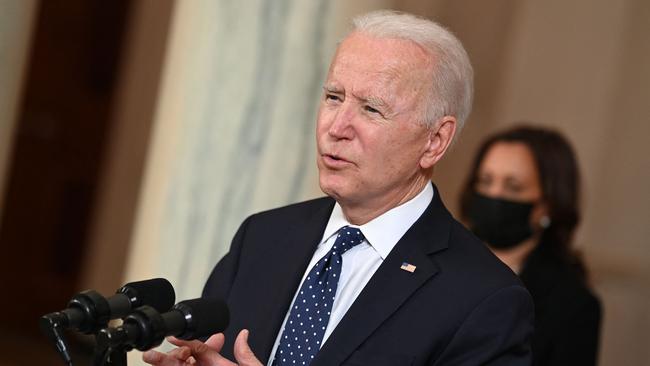Scott Morrison’s $565m plan to fast-track low emissions technology
The PM has unveiled a $565m plan that could see Australia lead the world in developing low emissions technology.
News
Don't miss out on the headlines from News. Followed categories will be added to My News.
Australia is putting $565m on the table to team up with other countries to fast-track low-emissions technology including green steel, batteries and small modular nuclear reactors.
Scott Morrison will unveil the cash injection — forecast to create up to 2500 jobs — before participating in Joe Biden’s climate leaders summit from Thursday night.
The Prime Minister hopes to leverage $3-$5 for every dollar Australia invests in partnership with countries such as the US, UK, Germany, Japan and Korea. He said he wanted Australia to lead the world in developing low-emissions technology.
“We want to stay ahead of the curve by working with international partners to protect the jobs we have in energy-reliant businesses, and create new jobs in the low -emissions technology sector,” Mr Morrison said.
“As we look to take advantage of these new export opportunities, we won’t look to reduce our own emissions by shutting down our existing export industries like agriculture, aluminium, coal and gas.”

The new investment, to be delivered over eight years, comes on top of $539m committed on Wednesday to new hydrogen hubs and carbon capture projects.
It will be targeted at the priorities of the government’s technology investment road map, including soil carbon measurement for farmers, low-carbon production of steel and aluminium, and low-cost and longer lasting battery storage.
The government is also keen to work with the US and the UK on researching new nuclear technology, although it has no plans to drop Australia’s ban on nuclear power.
Former chief scientist Alan Finkel, now Mr Morrison’s special adviser on low-emissions technology, has already engaged with the European Commission, Denmark and Austria, with India, Canada and New Zealand also seen as potential partners.
Dr Finkel said it was crucial to reduce the cost of emerging low-emissions technologies so they could replace more-polluting technologies.
Energy and Emissions Reduction Minister Angus Taylor said the technologies prioritised in the road map could “substantially reduce or eliminate emissions from sectors that account for 90 per cent of global emissions”.
“Australia won’t be able to make these technologies globally scalable and commercially viable all on our own,” he said. “Rapid progress and innovation can be achieved when the world works together towards a common goal.”
United States Studies Centre chief Professor Simon Jackman, a leading analyst on US-Australia relations, said Mr Morrison was unlikely to be treated harshly by the Mr Biden at the summit despite the predictions of environmental groups.
He said the summit was aimed at “nudging countries toward tangible goals”.
“You don’t invite people and wag a finger at them,” Prof Jackman said.

2021 CLIMATE SUMMIT EXPLAINED
WHAT IS JOE BIDEN’S CLIMATE SUMMIT?
The US President is gathering a group of 40 world leaders to urge major economies to take stronger climate action. Biden hopes it will spark a renewed effort to reduce carbon emissions ahead of November’s United Nations Climate Change Conference in Glasgow, focused on delivering the Paris Agreement’s commitment to keep the increase in global temperatures below 1.5C.
WHEN IS IT?
The virtual summit runs for two days from Thursday night.
WHO IS ATTENDING?
Scott Morrison is among leaders invited to attend including Chinese President Xi Jinping, UK Prime Minister Boris Johnson, Indian Prime Minister Narendra Modi, and European Commission President Ursula von der Leyen.
WHY IS IT IMPORTANT?
In a change of tack from his predecessor, Biden is expected to almost double his 2030 target for emissions reduction, to about 50 per cent compared with 2005 levels, arguing the world is moving too slowly towards net zero emissions which many countries plan to reach by 2050.
WHAT DOES IT MEAN FOR AUSTRALIA?
Under pressure to do more, Australia has not officially committed to reaching net zero emissions by 2050, and the existing 2030 target — of a 26-28 per cent reduction on 2005 levels — is significantly less ambitious than the goals outlined by Biden.
HOW WILL SCOTT MORRISON APPROACH THE SUMMIT?
The Prime Minister has been steadily ramping up his government’s climate change policies over recent months, starting with a speech in which he said he wanted Australia to reach net zero emissions “as soon as possible” and “preferably by 2050”. Morrison’s approach is focused on “technology not taxes”, and this week, he announced an extra $539m for new hydrogen hubs and carbon capture projects. The government has committed a further $565m to co-operate with other countries on Australian-based projects to develop new low emissions technologies. Morrison maintains the government is “meeting and beating” its existing commitments.
More Coverage
Originally published as Scott Morrison’s $565m plan to fast-track low emissions technology



